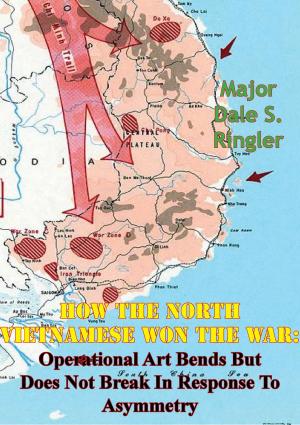The Vietnamese Air Force, 1951-1975 — An Analysis Of Its Role In Combat And Fourteen Hours At Koh Tang [Illustrated Edition]
Nonfiction, History, Military, Vietnam War, Asian, United States| Author: | Major A. J. C. Lavalle | ISBN: | 9781782898948 |
| Publisher: | Normanby Press | Publication: | August 15, 2014 |
| Imprint: | Normanby Press | Language: | English |
| Author: | Major A. J. C. Lavalle |
| ISBN: | 9781782898948 |
| Publisher: | Normanby Press |
| Publication: | August 15, 2014 |
| Imprint: | Normanby Press |
| Language: | English |
Illustrated with over 30 maps, diagrams and photos
As the final days of Vietnam unfolded, the question was raised, “What happened to the Vietnamese Air Force (VNAF)?" This monograph addresses that question in considerable detail. In order to sift out the story, three periods in the life of VNAF were selected-the Tet offensive of 1968, the Easter offensive of 1972, and lastly the March offensive of 1975. By examining each of these time periods, the factors at work in each period could be isolated so as to determine the performance of the VNAF.
The role of the USAF was dominant in the 1968 and 1972 offensives. Although VNAF had grown in size to about 44 squadrons and 42,000 people by the time of the 1972 offensive, application of airpower at the major points of the enemy assault was U.S. Further, the bombing of the North Vietnam heartland during these two periods was the compelling leverage that resulted in the initiation and pursuit of active negotiations to stop the war.
The intervening period between the peace agreement of January 27, 1973 and the North Vietnamese offensive of March 1975, was marked by fundamental changes in the character of the NVA forces and their deployment for battle. The NVA moved its center of logistics near the DMZ and into South Vietnam proper. The magnitude of SAM and AAA defenses constituted a major departure from those of the 1968 and 1972 campaigns. The VNAF, structured for a low scale war, was confronted with an enemy having the most sophisticated air defense weapons of the day.
Illustrated with over 30 maps, diagrams and photos
As the final days of Vietnam unfolded, the question was raised, “What happened to the Vietnamese Air Force (VNAF)?" This monograph addresses that question in considerable detail. In order to sift out the story, three periods in the life of VNAF were selected-the Tet offensive of 1968, the Easter offensive of 1972, and lastly the March offensive of 1975. By examining each of these time periods, the factors at work in each period could be isolated so as to determine the performance of the VNAF.
The role of the USAF was dominant in the 1968 and 1972 offensives. Although VNAF had grown in size to about 44 squadrons and 42,000 people by the time of the 1972 offensive, application of airpower at the major points of the enemy assault was U.S. Further, the bombing of the North Vietnam heartland during these two periods was the compelling leverage that resulted in the initiation and pursuit of active negotiations to stop the war.
The intervening period between the peace agreement of January 27, 1973 and the North Vietnamese offensive of March 1975, was marked by fundamental changes in the character of the NVA forces and their deployment for battle. The NVA moved its center of logistics near the DMZ and into South Vietnam proper. The magnitude of SAM and AAA defenses constituted a major departure from those of the 1968 and 1972 campaigns. The VNAF, structured for a low scale war, was confronted with an enemy having the most sophisticated air defense weapons of the day.
![Cover of the book The Vietnamese Air Force, 1951-1975 — An Analysis Of Its Role In Combat And Fourteen Hours At Koh Tang [Illustrated Edition] by Major A. J. C. Lavalle, Normanby Press](https://www.kuoky.com/images/2014/august/500x500/9781782898948-QvPi_500x.jpg)
![Cover of the book Famous Land Fights; A Popular Sketch Of The History Of Land Warfare [Illustrated Edition] by Major A. J. C. Lavalle](https://www.kuoky.com/images/2013/february/300x300/9781908902818-Qv4c_300x.jpg)




![Cover of the book Mafeking: A Diary Of The Siege [Illustrated Edition] by Major A. J. C. Lavalle](https://www.kuoky.com/images/2014/june/300x300/9781782891253-ZHWc_300x.jpg)




![Cover of the book With Kitchener To Khartum [Illustrated Edition] by Major A. J. C. Lavalle](https://www.kuoky.com/images/2014/august/300x300/9781782899235-69qS_300x.jpg)

![Cover of the book Letters Written During The Indian Mutiny [Illustrated Edition] by Major A. J. C. Lavalle](https://www.kuoky.com/images/2016/january/300x300/9781786257970-ysLN_300x.jpg)

